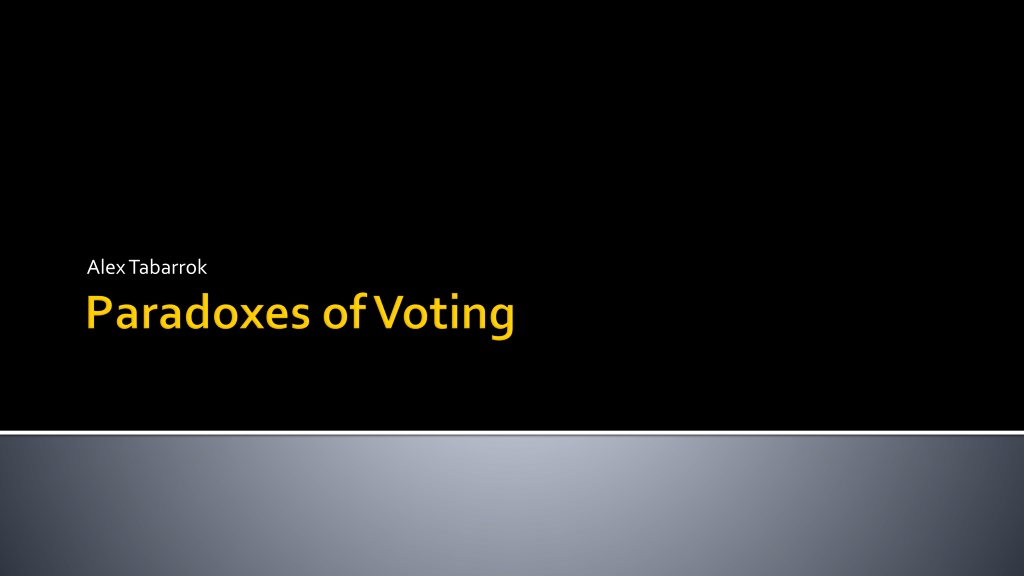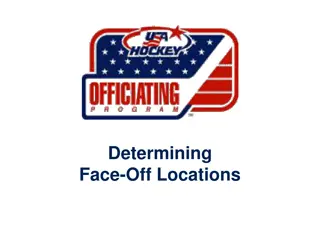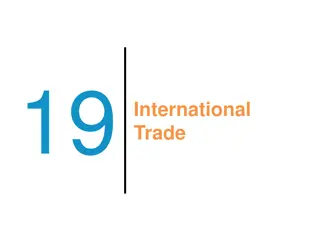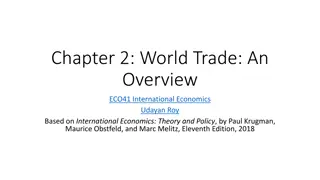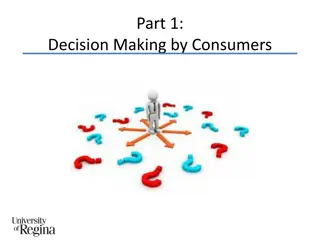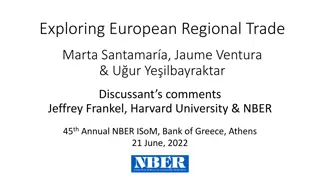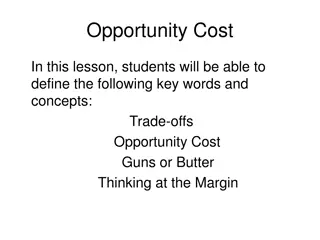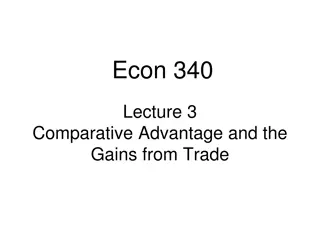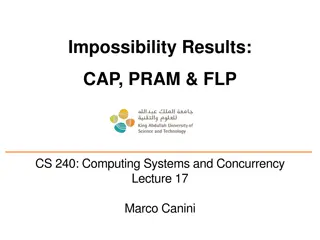Understanding Trade-offs in Resource Allocation
The content discusses various scenarios such as political elections and voting processes to illustrate how different choices can impact outcomes. It also touches on concepts like Condorcet winners, voting systems, and indifference curves to highlight the complexities of decision-making in economics and politics.
Download Presentation

Please find below an Image/Link to download the presentation.
The content on the website is provided AS IS for your information and personal use only. It may not be sold, licensed, or shared on other websites without obtaining consent from the author. Download presentation by click this link. If you encounter any issues during the download, it is possible that the publisher has removed the file from their server.
E N D
Presentation Transcript
Bush>Gore>Nader Gore>Bush Bush>Gore>Nader * Note also that if Gore>Bush and Gore>Nader, Gore was a Condorcet winner. Thus, plurality rule can fail to elect Condorcet winners.
Minnesota Gubernatorial Election, 1998 Rank 35% 28% 20% 17 % 1 Coleman Humphrey Ventura Ventura 2 Humphrey Coleman Coleman Humphrey 3 Ventura Ventura Humphrey Coleman Jesse Ventura: A Condorcet Loser (but not to his face)
Voting for Fruit Voter 1 Voter 2 Voter 3 A v. B -> A wins, A>B B v. C -> B wins, B>C C v. A -> C wins, C>A 1st Apples Bananas Coconuts 2nd Bananas Coconuts Apples 3rd Coconuts Apples Bananas
Rankings for President Voter L Voter M Voter R vs 1st Happy Grumpy Dopey 2nd Sneezy Dopey Happy 3rd Grumpy Happy Sleepy Dopey Happy 4th Dopey Bashful Sneezy 5th Dopey wins Doc Sleepy Grumpy 6th Bashful Sneezy Doc 7th Sleepy Doc Bashful
Happy v. Dopey Dopey wins Grumpy v. Dopey Grumpy wins Sneezy v. Grumpy Sneezy wins Sleepy v. Sneezy Sleepy wins Rankings for President Voter L Voter M Voter R 1st Happy Grumpy Dopey 2nd Sneezy Dopey Happy Bashful v. Sleepy Bashful wins Doc v. Bashful Doc is the winner! 3rd Grumpy Happy Sleepy 4th Dopey Bashful Sneezy But every voter prefers Happy to Doc! 5th Doc Sleepy Grumpy > 6th Bashful Sneezy Doc 7th Sleepy Doc Bashful
Recall that an indifference curve tells us all the combinations of two goods, say x and y, which give an individual equal utility. Typically we assume that more is better so utility is increasing in the NE direction.
Now suppose we have to choose among three goods: national defense, welfare, and private goods. The more we spend on national defense and welfare the more taxes have to be raised and so the less private goods are available. It's hard to draw pictures in three dimensions so we are going suppress the private goods dimension. Preferences can then described by circular indifference curves in two dimensions. The optimal amount of defense, welfare and private goods is indicated by the bliss point. The indifference curves tell us all the combinations of defense and welfare spending which give equal levels of utility.
Circular indifference curves are a simplification but a useful one. Two useful facts about circular indifference curves. If we want to compare two points to see which has higher utility all we have to do is see which point is closer to the bliss point. Draw a line from a circle's center (the bliss point) to the edge of the circle, i.e. a radius. Now draw a tangent to the circle at this point, the tangent to the circle will always be at an angle 90 degrees to the radius. We will not prove this result but a few example should convince you that it is true. If you move along the tangent in either direction away from the radius, utility is decreasing. (Can be shown using Pythagoras's theorem.) Thus (e.g.) x is preferred to y, x>y.
We have just proved that the distance from the bliss point is increasing as we move along the tangent away from the radius and we know this means that utility is decreasing. We can use these two facts to simplify our diagrams. Consider two voters with bliss points a and b.Now join the bliss points with a line (denoted ab) and consider any point off the line like z0. Draw a line from z0 perpendicular to the line ab (ie. it meets ab at an angle of 90 degrees). We know from the above proof that any point which is closer to ab than z0 (along the perpendicular) is preferred by both voters to z0. In a vote between z1 and z0, for example, voters a and b would both vote for z1.
z3 No Equilibrium Chaos! B z0 z2 A z1 C z4
Suppose preferences have a cycle then the agenda determines the outcome. In the US House of Congress, for example, the majority party and the speaker of the House have significant control over the agenda. By choosing whether to use Agenda One, Two, or Three the majority party can in some circumstances advantageously manipulate a series of votes. Cyclic Preferences Voter One Voter Two Voter Three A C B A C B First Best 2nd 3rd B C A
Suppose that z0 is the status quo and that b is the agenda setter. b can achieve his bliss point by setting up the following agenda z1 v. z0, winner v. z2, winner v. b. Following the agenda we have z1 z0 and z2 z1 and finally b z2, therefore b is the final outcome. (We have drawn in part of one of a's indifference curves in to indicate clearly that a prefers point b to z2, i.e. b is closer to a s bliss point than z2.
We have assumed that the issues up for vote are simply presented to the agents. More often, agents actively work to push the issues they are interested in onto the agenda. The opportunity to put an issue onto the agenda can be used to manipulate the final outcome. Suppose we have situation where a majority wants B and a minority wants C. In a vote between B and C, B will win. The minority, however, might be able to add items to the agenda so that C ends up winning the final vote. If the minority can find an issue A such that A B but C A then with the right agenda they can win. An issue like A, which is put onto the agenda in order to kill issue B and lose to issue C, is called a killer amendment. B A C A C B Winner=C
Killer amendments are hard for politicians to find. A must beat B but lose to C - such an issue may not exist. A prominent example, however, is the voting which occurred surrounding the adoption of the 17th Amendment to the U.S. Constitution, which made Senators directly elected by the people in 1913. Many senators from the South were in favor of the direct election but they were also didn't want the amendment to create a precedent for the Federal control of elections. Southern senators feared that if elections came under control of the Federal government the South's policy of excluding blacks from the political process would come to an end. The fears of the southern senators were probably justified as a number of northern Republicans wanted Federal control of elections in the South in order to enfranchise blacks who would overwhelmingly vote for Republicans. To meet this difficulty, southern and northern senators in favor of direct election hit upon a compromise-direct election of senators but with a provision protecting the South from Federal control. This was issue B. Not all senators wanted direct election. A prominent minority led by Senator Sutherland of Utah wanted to maintain the status quo, this was issue C. Senator and later Supreme Court Justice George Sutherland
If it came to a pairwise vote B (direct election + protection) would beat C (status quote, election by state legislatures). Sutherland's killer amendment was the direct election of senators but with no special provision for the South. Sutherland was against the direct election of senators but his amendment is in favor. Sutherland was hoping that his own amendment would eventually fail! Sutherland's amendment did fail, exactly as he had planned. First came the vote between A and B. Sutherland and everyone else against the direct election of senators voted for A as did Republicans who wanted direct election and a chance to enfranchise black voters in the South. A beat B. Now A was matched against C, the status quo. Sutherland and everyone else against the direct election of senators switched their votes from A to C. Sutherland's group was joined by Southern Democrats who favored the direct election of senators but who would not vote for direct election without special protection for the South. Although A gained more votes than C, A was defeated and the status quo won because a constitutional amendment requires a two-thirds majority. Sutherland's killer amendment was successful. Sutherland's success did not last long. A new Senate was able to pass the 17th amendment (without the protective clause) several months after Sutherland's brilliant politicking.
The story of the killer amendment shows that it is sometimes in a voter's interest to vote against the candidate or policy he most wants to win. When there are three or more choices all voting schemes suffer from this problem. That is, in all voting schemes it will sometimes be in a voter's interests to misrepresent his preferences, the way Sutherland did by voting for the direct election of senators.
Table 1: Failure of Positive Association Round One Round Two No candidate gets a majority. Number of Voters First Second Third A wins 6 6 6 4 2 3 A 9 B 10 C 8 A 15 B 12 A B C C A B B C A B A C C B A A C B Now reverse history. Suppose that Candidate A gives a great speech. 3 voters switch from B A C to A B C. 2 voters switch from C B A to C A B. Notice: The only change is that A is now more preferred to B (no change with C). Table 2: Failure of Positive Association Number of Voters First A C Second B A Third C B Round One Round Two C wins! 9 8 6 1 3 A 12 B 7 C 8 A 13 C 14 B C A B A C A C B A s great speech causes him to lose the election!
Group choice is no at all like individual choice. When an individual buys a quart of chocolate ice cream we have good reasons for thinking that he prefers chocolate to vanilla or strawberry ice cream. When a group of people buys a quart of chocolate ice cream we cannot make similar claims. Groups don t have smiles and groups don t have preferences. But groups don t even behave as if they had rational preferences. If we saw a group choosing apples rather than bananas and bananas rather than coconuts and if groups acted as if they had rational preferences we could predict that the group would choose apples rather than coconuts. We have given several examples of common voting schemes under which these predictions are false. Not only do groups not have preferences, groups do not act as if they had rational preferences.
There are many types of voting schemes and we have only looked at a handful. Perhaps with more perspiration and some inspiration too we will find or create a voting system under which groups do act as if they were rational individuals. Unfortunately, there is no such voting system and there never will be, this remarkable discovery was made by the economist Kenneth Arrow in 1951. Arrow showed that there is no voting system, no matter how clever or complex, that aggregates individual preferences so that groups behave as if they were rational individuals.
